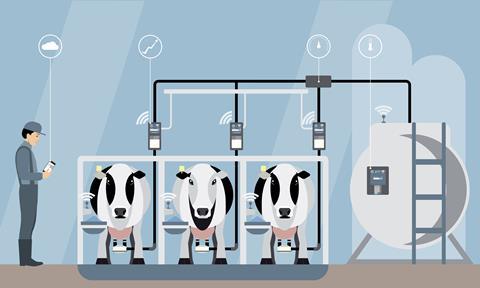With growing awareness of what can go wrong with their food before it reaches their plate, consumers are demanding more. Tracking technology and sensors could provide the answer

What is the latest focus for companies like Google and Amazon? The Internet of Things, blockchain, artificial intelligence? Actually, farmers, and the food supply chain they are a part of.
“Many of the newer technologies in the food industry are being driven by consumers, who have become much more engaged with food companies through social media,” says Swiss Re Corporate Solutions’ senior risk engineer Lisa Tischendorf.
Tischendorf explains that increased awareness of product recalls and outbreaks of foodborne illness has led the public to become far more concerned with supply chain risk.
“Consumers are demanding that retailers have transparency and traceability along the global food supply chain so contaminated products do not make it to grocery store shelves and onto their dinner table,” she says.
Tracking your meal
One way this is being done is with two-dimensional barcodes that are being tested right now to trace goods from farmer to food manufacturer to supermarket shelf. QR codes are one form of 2D barcode. They are the squares made up of other smaller squares that can often be seen on advertisements or concert tickets.
“In the future, items could be scanned with the barcodes at their source before entering the food supply chain and along their entire route to their final destination,” says Tischendorf. “The scans could one day be recorded sequentially on a blockchain-based digital platform, with multiple identical ledgers stored on multiple computers in multiple locations.”
This indelible record means that producers and distributors could almost immediately locate and recall batches of tainted food, significantly reducing liability.
Consumers are demanding that retailers have transparency and traceability along the global food supply chain so contaminated products do not make it to grocery store shelves and onto their dinner table
“However, this technology is not close to being fully implemented across the food supply chain. This will probably take years,” says Tischendorf.
“In the past, a trace might have taken days or even weeks exposing the general population to tainted food. With the barcodes, a trace might be reduced to minutes or seconds if this technology is successfully implemented across the global food supply chain,” she adds.
“This technology will also be able to pinpoint the source of the tainted products more precisely, reducing the amount of inventory – or wasted food – that will need to be destroyed in the event of a product recall.”
Hard to trace
But, Tischendorf warns, as simple as the technology may sound, implementing it is still a challenge. That’s because the food supply chain is extremely complex and includes everything from small farms in developing countries to supermarket giants like Walmart.
“Smaller farmers may not have the means or infrastructure in place to be included and may look for support from larger retailers, multinational companies, food manufacturers or local governments,” she says.
“Success will depend on the ability and level of willingness to participate along the global supply chain and consistency in data collection and storage.”
But it doesn’t stop there. There are other ways that technological advancements can make food safer.
The real ‘use by’ date
“Sensor technology is being explored as a means to monitor the condition of a food product, to more accurately predict when a product has become unsafe to eat, minimizing premature discarding of expired products,” Tischendorf says.
Sensors can monitor the quality and safety of food, whether it is on a pallet, in a case or individually wrapped. For example, a sensor tag is being developed that changes colour if a product has been exposed to a temperature above the recommended level.
Another sensor, also under development, changes colour after a package has been opened and indicates when the food should be discarded. Sensors that monitor the gaseous by-products of spoilage are also being worked on.
“Beyond preventing illness, these sensors will contribute to the reduction of wasted food by showing that food is still safe to eat,” says Tischendorf.
“Consumers will not be tied to the confusion around expiration dates, ‘use by’ dates, ‘sell by’ dates and ‘best by’ dates.”
“Beyond preventing illness, these sensors will contribute to the reduction of wasted food by showing that food is still safe to eat,” says Tischendorf.
“Consumers will not be tied to the confusion around expiration dates, ‘use by’ dates, ‘sell by’ dates and ‘best by’ dates.”
Beyond preventing illness, these sensors will contribute to the reduction of wasted food by showing that food is still safe to eat





